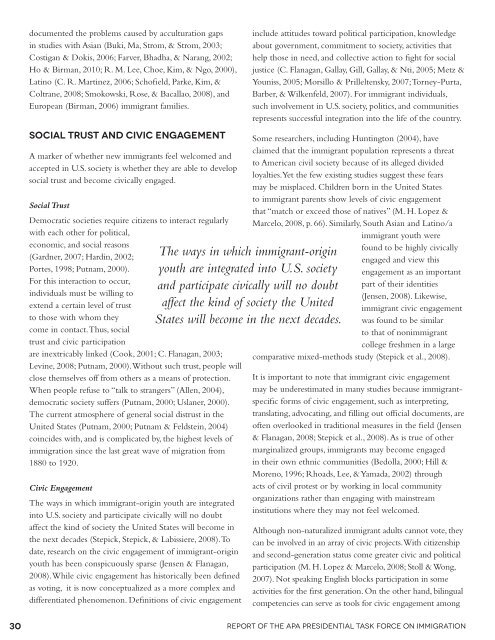Crossroads: The Psychology of Immigration in the New Century
Crossroads: The Psychology of Immigration in the New Century
Crossroads: The Psychology of Immigration in the New Century
You also want an ePaper? Increase the reach of your titles
YUMPU automatically turns print PDFs into web optimized ePapers that Google loves.
documented <strong>the</strong> problems caused by acculturation gaps<br />
<strong>in</strong> studies with Asian (Buki, Ma, Strom, & Strom, 2003;<br />
Costigan & Dokis, 2006; Farver, Bhadha, & Narang, 2002;<br />
Ho & Birman, 2010; R. M. Lee, Choe, Kim, & Ngo, 2000),<br />
Lat<strong>in</strong>o (C. R. Mart<strong>in</strong>ez, 2006; Sch<strong>of</strong>ield, Parke, Kim, &<br />
Coltrane, 2008; Smokowski, Rose, & Bacallao, 2008), and<br />
European (Birman, 2006) immigrant families.<br />
social Trust and Civic Engagement<br />
A marker <strong>of</strong> whe<strong>the</strong>r new immigrants feel welcomed and<br />
accepted <strong>in</strong> U.S. society is whe<strong>the</strong>r <strong>the</strong>y are able to develop<br />
social trust and become civically engaged.<br />
Social Trust<br />
Democratic societies require citizens to <strong>in</strong>teract regularly<br />
with each o<strong>the</strong>r for political,<br />
economic, and social reasons<br />
(Gardner, 2007; Hard<strong>in</strong>, 2002;<br />
Portes, 1998; Putnam, 2000).<br />
For this <strong>in</strong>teraction to occur,<br />
<strong>in</strong>dividuals must be will<strong>in</strong>g to<br />
extend a certa<strong>in</strong> level <strong>of</strong> trust<br />
to those with whom <strong>the</strong>y<br />
come <strong>in</strong> contact. Thus, social<br />
trust and civic participation<br />
are <strong>in</strong>extricably l<strong>in</strong>ked (Cook, 2001; C. Flanagan, 2003;<br />
Lev<strong>in</strong>e, 2008; Putnam, 2000). Without such trust, people will<br />
close <strong>the</strong>mselves <strong>of</strong>f from o<strong>the</strong>rs as a means <strong>of</strong> protection.<br />
When people refuse to “talk to strangers” (Allen, 2004),<br />
democratic society suffers (Putnam, 2000; Uslaner, 2000).<br />
<strong>The</strong> current atmosphere <strong>of</strong> general social distrust <strong>in</strong> <strong>the</strong><br />
United States (Putnam, 2000; Putnam & Feldste<strong>in</strong>, 2004)<br />
co<strong>in</strong>cides with, and is complicated by, <strong>the</strong> highest levels <strong>of</strong><br />
immigration s<strong>in</strong>ce <strong>the</strong> last great wave <strong>of</strong> migration from<br />
1880 to 1920.<br />
Civic Engagement<br />
<strong>The</strong> ways <strong>in</strong> which immigrant-orig<strong>in</strong> youth are <strong>in</strong>tegrated<br />
<strong>in</strong>to U.S. society and participate civically will no doubt<br />
affect <strong>the</strong> k<strong>in</strong>d <strong>of</strong> society <strong>the</strong> United States will become <strong>in</strong><br />
<strong>the</strong> next decades (Stepick, Stepick, & Labissiere, 2008). To<br />
date, research on <strong>the</strong> civic engagement <strong>of</strong> immigrant-orig<strong>in</strong><br />
youth has been conspicuously sparse (Jensen & Flanagan,<br />
2008). While civic engagement has historically been def<strong>in</strong>ed<br />
as vot<strong>in</strong>g, it is now conceptualized as a more complex and<br />
differentiated phenomenon. Def<strong>in</strong>itions <strong>of</strong> civic engagement<br />
<strong>The</strong> ways <strong>in</strong> which immigrant-orig<strong>in</strong><br />
youth are <strong>in</strong>tegrated <strong>in</strong>to U.S. society<br />
and participate civically will no doubt<br />
affect <strong>the</strong> k<strong>in</strong>d <strong>of</strong> society <strong>the</strong> United<br />
States will become <strong>in</strong> <strong>the</strong> next decades.<br />
<strong>in</strong>clude attitudes toward political participation, knowledge<br />
about government, commitment to society, activities that<br />
help those <strong>in</strong> need, and collective action to fight for social<br />
justice (C. Flanagan, Gallay, Gill, Gallay, & Nti, 2005; Metz &<br />
Youniss, 2005; Morsillo & Prilleltensky, 2007; Torney-Purta,<br />
Barber, & Wilkenfeld, 2007). For immigrant <strong>in</strong>dividuals,<br />
such <strong>in</strong>volvement <strong>in</strong> U.S. society, politics, and communities<br />
represents successful <strong>in</strong>tegration <strong>in</strong>to <strong>the</strong> life <strong>of</strong> <strong>the</strong> country.<br />
Some researchers, <strong>in</strong>clud<strong>in</strong>g Hunt<strong>in</strong>gton (2004), have<br />
claimed that <strong>the</strong> immigrant population represents a threat<br />
to American civil society because <strong>of</strong> its alleged divided<br />
loyalties. Yet <strong>the</strong> few exist<strong>in</strong>g studies suggest <strong>the</strong>se fears<br />
may be misplaced. Children born <strong>in</strong> <strong>the</strong> United States<br />
to immigrant parents show levels <strong>of</strong> civic engagement<br />
that “match or exceed those <strong>of</strong> natives” (M. H. Lopez &<br />
Marcelo, 2008, p. 66). Similarly, South Asian and Lat<strong>in</strong>o/a<br />
immigrant youth were<br />
found to be highly civically<br />
engaged and view this<br />
engagement as an important<br />
part <strong>of</strong> <strong>the</strong>ir identities<br />
(Jensen, 2008). Likewise,<br />
immigrant civic engagement<br />
was found to be similar<br />
to that <strong>of</strong> nonimmigrant<br />
college freshmen <strong>in</strong> a large<br />
comparative mixed-methods study (Stepick et al., 2008).<br />
It is important to note that immigrant civic engagement<br />
may be underestimated <strong>in</strong> many studies because immigrantspecific<br />
forms <strong>of</strong> civic engagement, such as <strong>in</strong>terpret<strong>in</strong>g,<br />
translat<strong>in</strong>g, advocat<strong>in</strong>g, and fill<strong>in</strong>g out <strong>of</strong>ficial documents, are<br />
<strong>of</strong>ten overlooked <strong>in</strong> traditional measures <strong>in</strong> <strong>the</strong> field (Jensen<br />
& Flanagan, 2008; Stepick et al., 2008). As is true <strong>of</strong> o<strong>the</strong>r<br />
marg<strong>in</strong>alized groups, immigrants may become engaged<br />
<strong>in</strong> <strong>the</strong>ir own ethnic communities (Bedolla, 2000; Hill &<br />
Moreno, 1996; Rhoads, Lee, & Yamada, 2002) through<br />
acts <strong>of</strong> civil protest or by work<strong>in</strong>g <strong>in</strong> local community<br />
organizations ra<strong>the</strong>r than engag<strong>in</strong>g with ma<strong>in</strong>stream<br />
<strong>in</strong>stitutions where <strong>the</strong>y may not feel welcomed.<br />
Although non-naturalized immigrant adults cannot vote, <strong>the</strong>y<br />
can be <strong>in</strong>volved <strong>in</strong> an array <strong>of</strong> civic projects. With citizenship<br />
and second-generation status come greater civic and political<br />
participation (M. H. Lopez & Marcelo, 2008; Stoll & Wong,<br />
2007). Not speak<strong>in</strong>g English blocks participation <strong>in</strong> some<br />
activities for <strong>the</strong> first generation. On <strong>the</strong> o<strong>the</strong>r hand, bil<strong>in</strong>gual<br />
competencies can serve as tools for civic engagement among<br />
30 Report <strong>of</strong> <strong>the</strong> APA Presidential Task Force on <strong>Immigration</strong>
















